Steps for Winning World Competition Brisket
Jump To Recipe
In the world of competition BBQ, some consider brisket the toughest cut of meat to master.
Traeger BBQ Pro and competition BBQ champion, Chad Ward provided some tips to help you cut the learning curve and grab your brisket trophy sooner than later.
Quality Product
In competition BBQ, it’s all about the quality of meat. When you start with a quality cut of brisket, the odds are in your favor. Your local butcher can help educate you about types and breeds of beef to consider for creating the best possible competition brisket, so consult the professional before you begin.
Key factors to a quality grade of brisket:
Marbling – Marbling is fat and the more fat on a slab of brisket, the more flavorful your brisket will be. An abundance of marbling will provide you with a very moist and tender product when cooked correctly.
Grade & BREED – Wagyu brisket has a high level of marbling and moisture, which makes brisket tender and allows you a small margin of error if not cooked perfectly. A Wagyu brisket averages around $150, but the Wagyu flavor makes it worth every cent and will give you the best opportunity to grace the winner’s circle. If your budget doesn’t allow for Wagyu, use a USDA Prime Grade brisket from another breed of cattle. They have a good amount of marbling and will still produce a great brisket.
The Entry Box
Brisket is made up of two muscles, the point and the flat. The point always has the most marbling and is what you cube and submit for judging as burnt ends in a BBQ competition. Another component for your entry will be the sliced brisket which comes from the flat. The marbling in the flat isn’t as plentiful as in the point so you must really monitor it so it doesn’t dry out.
The flat should be sliced about as wide as a pencil and against the grain. When competing in BBQ, only turn in burnt ends if they’ve rendered out all the fat and taste as good as the sliced brisket. Many competitors feel that they must put burnt ends in the turn-in box—That is not the case! Judges can only score your entry on what you provide, so put your best brisket forward and don’t give them a reason to lower your score. The competition category is brisket, so burnt ends don’t have to be in your box.
Flavor
The desired flavor for brisket slices from the flat is beef. Don’t get carried away adding sweet or heat, let the brisket flavor shine.
Burnt ends are a different story—Judges often refer to burnt ends as meat candy. They look at burnt ends as their gift, the morsel of sweet beef that will melt in their mouth at the end of the contest. So, if you’re submitting brisket burnt ends, don’t let the competition judges down. Finish burnt ends with a sweet sauce and a little Turbinado Sugar (raw, pure cane sugar), then place them back in the smoker for 30 to 45 minutes to allow the beef and sweet to meld together. They will taste amazing.

Competition Style BBQ Brisket
by Traeger Kitchen
27 Reviews
Prep Time
30 Min
Cook Time
10 Hr
Serves
8
Pellets
Pecan
Clear some space in the trophy case because our competition-style brisket recipe will have you wrapped up in winning wood-fired flavor.
Ingredients
main
| 1 | (12-16 lb) whole packer brisket |
| 3 Cup | water |
| 1/4 Cup | Butcher BBQ Beef Injection |
| 1 Teaspoon | white pepper |
| 1 Teaspoon | onion powder |
| 1 Teaspoon | garlic powder |
| 1 Tablespoon | beef bouillon |
| 1 Cup | kosher salt |
| 3/4 Cup | Black pepper |
| To Taste | Traeger Coffee Rub |
| 2 Cup | beef broth |
Special Equipment
| meat injector |
1
When ready to cook, set the Traeger temperature to 225℉ and preheat with the lid closed for 15 minutes. For optimal flavor, use Super Smoke, if available.
2
Trim all of the fat off the top of the brisket. Trim the fat cap on the bottom to 1/4 inch thick.
3
In a large liquid measuring cup or medium bowl, combine the water, Butcher BBQ Beef Injection, white pepper, onion powder, garlic powder, and beef bouillon.
4
Use a meat injector to inject the liquid across the top of the brisket in a 1-inch checkerboard pattern.
5
Season the brisket with salt, pepper, and Traeger Coffee Rub.
6
Insert the probe into the thickest part of the brisket. Place the brisket directly on the grill grates, fat-side up. Close the lid and smoke until the internal temperature reaches 160°F, 4-5 hours.
7
Remove the brisket from the grill and wrap in a double layer of heavy-duty aluminum foil, leaving one end open. Pour the beef broth into the opening, then seal the packet.
8
Return the brisket to the grill and re-insert the probe. Increase the grill temperature to 250℉. Close the lid and cook until the internal temperature reaches 204°F, 4-5 hours more, depending on the size of the brisket.
9
Remove the brisket from the grill and wrap in a towel. Let rest for 1 hour.
10
Unwrap the brisket and slice against the grain. Enjoy!